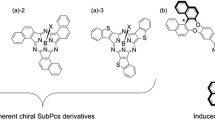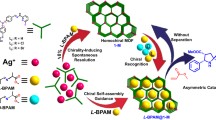Abstract
The construction of molecular chirality is crucial for exploring novel luminophores with chiroptical properties. Classic asymmetric synthesis of chiral center or axial is not powerful enough on through-space architecture. Accessible methodologies for breaking molecular symmetry could be promising but remain less investigated. Herein, we report a novel methodology for constructing chiral through-space luminophores via simple chlorination on bridged carbazole motifs. The chlorination breaks the molecular symmetry and thus results in molecular chirality by eliminating the mirror plane or rotating axis. Interestingly, continuous multiple chlorinations can rebuild and break the symmetry of the skeleton in succession. Several chiral and achiral isomeric analogues are synthesized and characterized with impressive chiroptical properties. Results of chiral high performance liquid chromatography (HPLC), single-crystal X-ray diffraction, kinetic racemization, and chiroptical property investigation demonstrate the effectiveness of our rational design strategy. It provides a feasible methodology for exploring novel chiral luminescent materials based on versatile though-space skeletons.

Similar content being viewed by others
References
Qiao J, He Y, Lin S, Fan Q, Guo J. J Mater Chem C, 2022, 10: 7311–7318
Campeau LC, Parisien M, Jean A, Fagnou K. J Am Chem Soc, 2006, 128: 581–590
Zhang C, Li ZS, Dong XY, Niu YY, Zang SQ. Adv Mater, 2022, 34: 2109496
Yuan YX, Jia JH, Song YP, Ye FY, Zheng YS, Zang SQ. J Am Chem Soc, 2022, 144: 5389–5399
Frédéric L, Desmarchelier A, Plais R, Lavnevich L, Muller G, Villafuerte C, Clavier G, Quesnel E, Racine B, Meunier-Della-Gatta S, Dognon JP, Thuéry P, Crassous J, Favereau L, Pieters G. Adv Funct Mater, 2020, 30: 2004838
Kong FC, Yang SY, Liao XJ, Feng ZQ, Shen WS, Jiang ZQ, Zhou DY, Zheng YX, Liao LS. Adv Funct Mater, 2022, 32: 2201512
Li M, Li SH, Zhang D, Cai M, Duan L, Fung MK, Chen CF. Angew Chem Int Ed, 2018, 57: 2889–2893
Tu ZL, Yan ZP, Liang X, Chen L, Wu ZG, Wang Y, Zheng YX, Zuo JL, Pan Y. Adv Sci, 2020, 7: 2000804
Wang YF, Lu HY, Chen C, Li M, Chen CF. Org Electron, 2019, 70: 71–77
Yang CJ, Zhang C, Gu QS, Fang JH, Su XL, Ye L, Sun Y, Tian Y, Li ZL, Liu XY. Nat Catal, 2020, 3: 539–546
Ouyang GH, He YM, Li Y, Xiang JF, Fan QH. Angew Chem Int Ed, 2015, 54: 4334–4337
Lee JJ, Kim BC, Choi HJ, Bae S, Araoka F, Choi SW. ACS Nano, 2020, 14: 5243–5250
Yang D, Han J, Sang Y, Zhao T, Liu M, Duan P. J Am Chem Soc, 2021, 143: 13259–13265
Tsuji H, Nakamura E. Acc Chem Res, 2019, 52: 2939–2949
Wang YD, Shao JY, Lan ZR, Zhong YW. Org Mater, 2022, 4: 28–35
Takaishi K, Murakami S, Yoshinami F, Ema T. Angew Chem Int Ed, 2022, 61
Li ZQ, Gong ZL, Shao JY, Yao J, Zhong YW. Angew Chem Int Ed, 2021, 60: 14595–14600
Zhou M, Sang Y, Jin X, Chen S, Guo J, Duan P, Liu M. ACS Nano, 2021, 15: 2753–2761
Yang SY, Wang YK, Peng CC, Wu ZG, Yuan S, Yu YJ, Li H, Wang TT, Li HC, Zheng YX, Jiang ZQ, Liao LS. J Am Chem Soc, 2020, 142: 17756–17765
Li Q, Hu J, Lv J, Wang X, Shao S, Wang L, Jing X, Wang F. Angew Chem Int Ed, 2020, 59: 20174–20182
Zhang YP, Liang X, Luo XF, Song SQ, Li S, Wang Y, Mao ZP, Xu WY, Zheng YX, Zuo JL, Pan Y. Angew Chem Int Ed, 2021, 60: 8435–8440
Feuillastre S, Pauton M, Gao L, Desmarchelier A, Riives AJ, Prim D, Tondelier D, Geffroy B, Muller G, Clavier G, Pieters G. J Am Chem Soc, 2016, 138: 3990–3993
Imagawa T, Hirata S, Totani K, Watanabe T, Vacha M. Chem Commun, 2015, 51: 13268–13271
Sharma N, Spuling E, Mattern CM, Li W, Fuhr O, Tsuchiya Y, Adachi C, Bräse S, Samuel IDW, Zysman-Colman E. Chem Sci, 2019, 10: 6689–6696
Wang Y, Zhang Y, Hu W, Quan Y, Li Y, Cheng Y. ACS Appl Mater Interfaces, 2019, 11: 26165–26173
Wu ZG, Han HB, Yan ZP, Luo XF, Wang Y, Zheng YX, Zuo JL, Pan Y. Adv Mater, 2019, 31: 1900524
Zhen S, Mao JC, Chen L, Ding S, Luo W, Zhou XS, Qin A, Zhao Z, Tang BZ. Nano Lett, 2018, 18: 4200–4205
Yu J, Ma H, Huang W, Liang Z, Zhou K, Lv A, Li XG, He Z. JACS Au, 2021, 1: 1694–1699
Wang S, Hu D, Guan X, Cai S, Shi G, Shuai Z, Zhang J, Peng Q, Wan X. Angew Chem Int Ed, 2021, 60: 21918–21926
Krzeszewski M, Ito H, Itami K. J Am Chem Soc, 2022, 144: 862–871
Takaishi K, Iwachido K, Takehana R, Uchiyama M, Ema T. J Am Chem Soc, 2019, 141: 6185–6190
Hassan Z, Spuling E, Knoll DM, Lahann J, Bräse S. Chem Soc Rev, 2018, 47: 6947–6963
Gong ZL, Zhu X, Zhou Z, Zhang SW, Yang D, Zhao B, Zhang YP, Deng J, Cheng Y, Zheng YX, Zang SQ, Kuang H, Duan P, Yuan M, Chen CF, Zhao YS, Zhong YW, Tang BZ, Liu M. Sci China Chem, 2021, 64: 2060–2104
Tsujimoto H, Ha DG, Markopoulos G, Chae HS, Baldo MA, Swager TM. J Am Chem Soc, 2017, 139: 4894–4900
Luo J, Xu X, Mao R, Miao Q. J Am Chem Soc, 2012, 134: 13796–13803
Penty SE, Zwijnenburg MA, Orton GRF, Stachelek P, Pal R, Xie Y, Griffin SL, Barendt TA. J Am Chem Soc, 2022, 144: 12290–12298
Mayorga Burrezo P, Jiménez VG, Blasi D, Ratera I, Campana AG, Veciana J. Angew Chem Int Ed, 2019, 58: 16282–16288
Tang ML, Oh JH, Reichardt AD, Bao Z. J Am Chem Soc, 2009, 131: 3733–3740
Okazaki M, Mizusawa T, Nakabayashi K, Yamashita M, Tajima N, Harada T, Fujiki M, Imai Y. J Photochem Photobiol A, 2016, 331: 115–119
Acknowledgements
This work was supported by the National Natural Science Foundation of China (21975061) and Shenzhen Fundamental Research Program (JCYJ20190806142403535, GXWD2020123015542700 320200728150952003).
Author information
Authors and Affiliations
Corresponding author
Additional information
Conflict of interest
The authors declare no conflict of interest.
Supporting information
The supporting information is available online at http://chem.scichina.com and http://link.springer.com/journal/. The supporting materials are published as submitted, without typesetting or editing. The responsibility for scientific accuracy and content remains entirely with the authors.
Rights and permissions
About this article
Cite this article
Xie, Y., Liu, H., Li, Z. et al. Construction of chiral through-space luminophores via symmetry breaking triggered by sequenced chlorination. Sci. China Chem. 66, 2083–2090 (2023). https://doi.org/10.1007/s11426-023-1560-0
Received:
Accepted:
Published:
Issue Date:
DOI: https://doi.org/10.1007/s11426-023-1560-0




